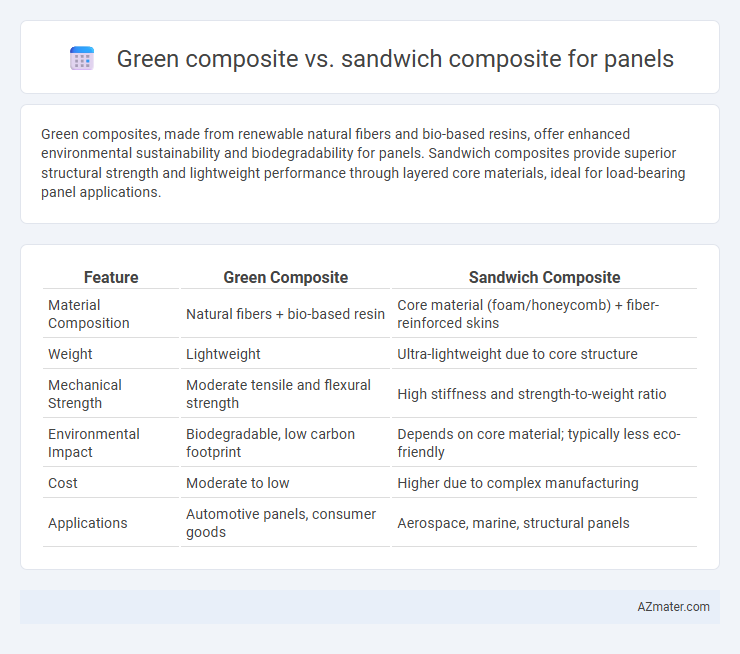Green composites, made from renewable natural fibers and bio-based resins, offer enhanced environmental sustainability and biodegradability for panels. Sandwich composites provide superior structural strength and lightweight performance through layered core materials, ideal for load-bearing panel applications.
Table of Comparison
| Feature | Green Composite | Sandwich Composite |
|---|---|---|
| Material Composition | Natural fibers + bio-based resin | Core material (foam/honeycomb) + fiber-reinforced skins |
| Weight | Lightweight | Ultra-lightweight due to core structure |
| Mechanical Strength | Moderate tensile and flexural strength | High stiffness and strength-to-weight ratio |
| Environmental Impact | Biodegradable, low carbon footprint | Depends on core material; typically less eco-friendly |
| Cost | Moderate to low | Higher due to complex manufacturing |
| Applications | Automotive panels, consumer goods | Aerospace, marine, structural panels |
Introduction to Composite Panels
Composite panels are engineered materials combining multiple layers to enhance strength, durability, and lightweight properties. Green composite panels integrate natural fibers such as hemp or flax with bio-based resins, offering eco-friendly benefits and reduced environmental impact. Sandwich composite panels consist of two strong outer layers bonded to a lightweight core, providing superior stiffness and thermal insulation, commonly used in aerospace and construction industries.
Overview of Green Composites
Green composites are primarily composed of natural fibers such as flax, hemp, or jute combined with bio-based or recyclable matrices, offering enhanced environmental sustainability and reduced carbon footprint compared to traditional composites. These materials provide a balance of lightweight properties, good mechanical strength, and biodegradability, making them ideal for eco-friendly panel applications in automotive, construction, and aerospace industries. Their renewable sourcing and potential for lower energy consumption during manufacturing distinguish green composites from conventional sandwich composites, which typically use synthetic cores and face sheets.
Understanding Sandwich Composites
Sandwich composites consist of two strong outer skins bonded to a lightweight core, offering exceptional stiffness-to-weight ratios ideal for panel applications. Their layered structure enhances impact resistance and thermal insulation compared to traditional green composites made from natural fibers and resins. This design enables sandwich composites to deliver superior mechanical performance and durability in aerospace, automotive, and construction industries.
Material Composition: Green vs Sandwich
Green composites primarily consist of natural fibers such as flax, hemp, or jute combined with biodegradable or bio-based resins, emphasizing sustainability and reduced environmental impact. Sandwich composites are typically engineered with a core material like foam or honeycomb sandwiched between two composite face sheets made of synthetic fibers such as carbon or glass, optimizing strength-to-weight ratio and structural performance. The material composition in green composites favors eco-friendly resources, while sandwich composites prioritize mechanical efficiency and lightweight durability.
Mechanical Properties Comparison
Green composites exhibit enhanced biodegradability and lower environmental impact compared to sandwich composites, while maintaining comparable mechanical strength and stiffness. Sandwich composites typically offer higher specific strength and superior impact resistance due to their core and face-sheet architecture, making them suitable for load-bearing panels. Mechanical properties such as tensile strength, flexural modulus, and impact energy absorption vary depending on material constituents, with green composites excelling in lightweight applications and sandwich composites favored for structural durability.
Environmental Impact and Sustainability
Green composites utilize natural fibers such as flax, hemp, or jute combined with bio-based resins, significantly reducing carbon footprint and promoting biodegradability compared to traditional materials. Sandwich composites, often consisting of synthetic core materials like foam or honeycomb structures paired with fiber-reinforced facings, can offer superior strength-to-weight ratios but generally involve less eco-friendly, non-renewable components. Evaluating environmental impact, green composites provide improved sustainability through reduced reliance on petrochemicals and enhanced end-of-life options, whereas sandwich composites may pose challenges in recycling and disposal due to mixed material layers.
Weight and Strength Considerations
Green composites, composed mainly of natural fibers and bio-based resins, offer significant weight reductions compared to traditional materials, making them ideal for lightweight panel applications. Sandwich composites incorporate a core material, such as foam or honeycomb, between two strong face sheets, enhancing overall strength and stiffness while maintaining low weight. Weight-to-strength ratio often favors sandwich composites in structural applications, whereas green composites provide environmentally friendly alternatives with moderate strength suited for less demanding uses.
Applications in Industry
Green composites, made from natural fibers and biodegradable resins, are increasingly utilized in automotive and construction industries for lightweight, eco-friendly panels that improve sustainability and reduce carbon footprints. Sandwich composites, consisting of a lightweight core material sandwiched between two fiber-reinforced face sheets, dominate aerospace and marine applications due to their superior strength-to-weight ratio and high impact resistance. Both composites enable enhanced structural performance and weight reduction, critical for energy-efficient designs in transportation and infrastructure sectors.
Cost Analysis: Green vs Sandwich Panels
Green composite panels generally offer lower material costs due to the use of natural fibers like hemp or flax combined with bio-resins, reducing reliance on expensive synthetic components. Sandwich composite panels, typically composed of two high-strength face sheets bonded to a lightweight core such as foam or honeycomb, can incur higher manufacturing and material expenses because of their complex structure. Cost analysis reveals green composites provide a more economical option for applications prioritizing sustainability, while sandwich composites justify their premium pricing with superior mechanical properties and lightweight performance.
Future Trends and Innovations
Green composite panels are gaining traction due to biodegradability and use of renewable fibers like hemp and flax, driving sustainability in construction and automotive sectors. Sandwich composites, combining lightweight cores such as foam or honeycomb with durable skins, are evolving with advanced materials like bio-based resins and nanotechnology to enhance strength-to-weight ratios. Future innovations focus on hybrid green-sandwich composites that optimize environmental impact while maximizing mechanical performance and thermal insulation.

Infographic: Green composite vs Sandwich composite for Panel
 azmater.com
azmater.com